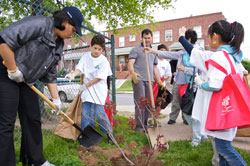Tree Planting Tips
Digging The Hole

"It’s better to plant a $100 tree in a $200 hole than plant a $200 tree in a $100 hole."
- International Society of Arborists
The most common mistake when planting a tree is digging a hole that is too deep or too narrow. If a hole is too deep, the roots will not have access to enough oxygen to ensure proper growth. If the hole is too narrow, the roots can not expand sufficiently to nourish and properly anchor the tree.
- Dig a hole that is at least 6 inches wider than the container on all sides.
- Dig a hole almost as deep as the top of the root ball.
Once in the ground, the soil level of the new tree should be slightly higher (1/2 inch) than the soil surrounding the hole. The width of the hole should be at least 2 times the diameter of the container.
Hint for digging in Baltimore: When digging in poorly drained clay soil, it is important to avoid ‘glazing’. Glazing occurs when the sides and bottom of a hole become smoothed forming a barrier, through which water has difficulty passing. To break up the glaze, use a fork to work the bottom and drag the points of the fork along the sides of the completed hole. Also, raise the center bottom of the hole slightly higher than the surrounding area. This allows water to disperse, reducing the possibility of water pooling in the root zone.
Planting: The Tree
"The best time to plant a tree was 20 years ago, the second best time is today!"
- Anonymous
Container Trees
- Carefully remove the tree from the container and check the roots. If the tree is difficult to remove, place the pot on its side, tap it gently but firmly all the way around, and the root-ball should loosen.
- If the roots are tightly packed together or ‘potbound’, use your fingers or a blunt instrument (to minimize root tearing) to carefully pull out the fine roots.
- Prune dead or crushed roots and straighten or cut circling roots, making clean cuts.
- Lift the tree into planting space by the root ball, not the trunk.
- Balance the tree upright in the center of the planting space.
- Never plant too deep. The trunk flare and top of root ball should be at grade (the trunk flare may be hidden within the root ball.) The trunk must always be in open air, and the roots must be underground. If you dug the hole too deep, lift the tree back out of the hole by the root-ball, not the trunk, add dirt, tamp down well, then replace the tree. If too shallow, dig a little deeper.
- Once the tree is seated in the center of the hole, the original soil is back-filled into the hole around (and not on top of) the tree. Remember not to overly compress the back-filled soil around the tree, especially by tramping it with your feet. Compress gently using your hands instead.
- Prune only dead or injured branches.
Additional resources for tree planting can be found on the Arbor Day Foundation’s website
Watering: The Tree
Newly planted trees should be watered at the time of planting.
During the first growing season, trees should be watered at least once a week in the absence of rain and twice a week during the height of the summer. However, care should be taken not to overwater as this may result in oxygen deprivation.
If you are uncertain as to whether a tree needs watering, dig down 6-8 inches at the edge of the planting hole. If the soil at that depth feels powdery or crumbly, the tree needs water. Adequately moistened soil should form a ball when squeezed.
Regular deep soakings are better than frequent light wettings. Moisture should reach a depth of 12 to 18 inches below the soil surface to encourage ideal root growth.
Mulching: The Tree
Mulch lightly and evenly with a 3" depth of composted material or wood chips at least to the diameter of the crown of the tree. Be sure to leave a 3" circle of bare soil around the trunk. Deep layers of mulch especially piled against the trunk can create insect or disease problems.
Mulching is important to conserve moisture and promote water and air penetration. Mulch material can be wood chips, leaves or grass clippings.
Soil Testing
Since all soils have a history, it can be beneficial to get soil analyzed properly for macronutrients such as Nitrogen (N), Phosphorus (P) and Potassium (K), micronutrients, pH, soil type, and drainage. Information on soil tests can be found at the Maryland Cooperative Extension website http://extension.umd.edu/.